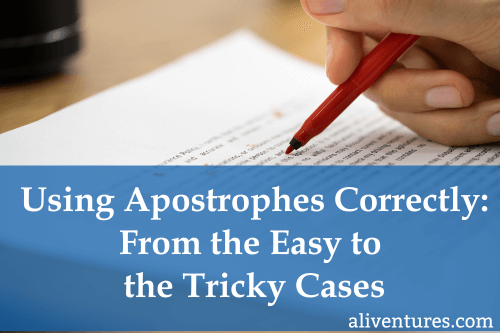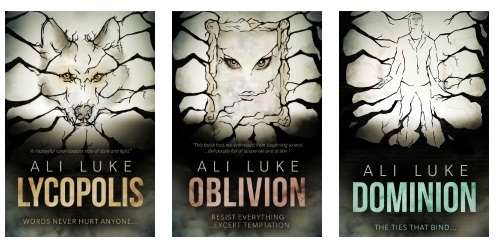Using Apostrophes Correctly: From the Easy to the Tricky Cases

This post was first published in November 2016 and last updated in May 2025.
I think it’s a safe bet that you’ve come across the apostrophe before. (If not … there are two in the previous sentence.)
However, quite a few writers struggle with using apostrophes correctly. And that can really damage your credibility. Whether you’re entering short story competitions, submitting your manuscript to literary agents, or self-publishing your novel, a missing or misplaced apostrophe will make your writing look unpolished, at best.
The good news is, it’s really not too tricky to get apostrophes right.
We’ll run through the basics of apostrophes, because even if you think you know the ins and outs of this little punctuation mark, it’s always good to be certain! Then, we’ll cover the tricky cases that often trip up even highly experienced writers.
The Two Basic Uses of Apostrophes
In English, apostrophes are used for two primary reasons:
- To indicate possession
- To indicate omitted letters
They are never used to indicate a plural.
That’s so important that I’m going to say it again: apostrophes are NEVER used for plurals.
Apostrophes for Indicating Possession
Examples: This is Sarah’s piece of cake. Where is the dog’s ball?
Here, “apostrophe+s” is added to “Sarah” and to “dog”, creating the possessive form of these nouns.
Most people find this type of apostrophe pretty straightforward to use. (We’ll come onto some trickier cases later, though.)
Apostrophes for Indicating Omitted Letter(s) in Contractions
Example: That isn’t your cake. Here’s the ball.
Here, “isn’t” is a contraction of the words “is not” and “here’s” a contraction of “here is”. The apostrophe is positioned where the missing letter would otherwise be.
Apostrophes are NOT for Plurals
In English, most plural nouns are formed by adding -s to the end of a word.
One book … Two books
One carrot … Two carrots
You do NOT use an apostrophe in plurals. This is such a common mistake, and crops up quite often on shop signs and restaurant menus advertising things like “carrot’s, potato’s, onion’s”.
I can see why this happens, because adding s for a plural is dangerously similar to adding ‘s for a possessive. If you find yourself making this mistake, always proofread carefully and double-check all your apostrophes.
Where Apostrophes Get Tricky
There are a few cases where apostrophes can be particularly confusing.
Possessive Apostrophe: Names ending in “S”
Sarah’s cake is easy … but what if the cake belongs to Chris?
There’s no firm rule on this, and different editors will do things slightly differently.
If you want to stick to the most common conventions, you should do the same as you do with any name – add an apostrophe and an S:
Chris’s cake.
Some people prefer to write it as Chris’, which might be considered less formally correct, but isn’t likely to bother most readers.
For Biblical and classical names, it’s conventional to leave off the final S:
Jesus’ disciples.
Socrates’ teachings.
Again, though, if you add a final S to these, it’s unlikely to bother your readers.
Possessive Apostrophe: Plural Noun
How about if the cake belongs to a group of teachers?
The convention here is to add the apostrophe but omit the additional S:
The teachers’ cake.
The horses’ stable.
The boys’ room.
Note that plural nouns that don’t end in an S are treated in the normal way:
The children’s lunch.
The women’s group.
Possessive Pronouns: His, Her, Your, Its
“Pronouns” are the little words that stand in for names: I, you, she, he, it, we, they, who.
When these become possessive, they do not gain an apostrophe:
- This is my ball … the ball is mine
- This is your ball … the ball is yours
- This is her ball … the ball is hers – I’ve sometimes seen “her’s”, incorrectly
- This is his ball … the ball is his
- This is its ball … the ball is its – this one often trips people up, because the word “it’s” exists too (a contraction of “it is” or “it has”).
- This is our ball … the ball is ours
- This is their ball … the ball is theirs – this one is tricky too, because the word “they’re” (“they are”) exists as well, and “theirs” is sometimes incorrectly written “their’s” or even “there’s”.
- Who owns this ball … whose is it? – often confused with “who’s” (which means “who is” or “who has”).
Whenever you’re using a pronoun in the possessive form, double-check that you haven’t included an apostrophe.
Possessive Pronouns: Company Names
Some companies drop the apostrophe from their name to make it more streamlined: there’s a whole post about this practice here.
In this case, use whatever the company uses as their official name on their logo, shops, brochures, website, etc even if it’s not grammatically correct. E.g. write “Waterstones” not “Waterstone’s”.
Joint Possession: Where to Put the Apostrophe?
Another tricky situation is where an item belongs to two people.
Let’s say your protagonist, Jane, has been invited to dinner with her uncle and aunt. You write:
Jane arrived at her uncle and aunt’s house.
The second person in the sentence gets the apostrophe, as the house belongs to the uncle and aunt as a unit.
But let’s say Jane’s uncle and aunt each, separately, own lots of books. In this case, you use the apostrophe for each person, as the ownership of the books is individual, not joint.
Jane glanced over her uncle’s and aunt’s books in the living room.
(Personally, I feel this looks a bit clunky, and I’d probably find a different way to phrase the sentence! But grammatically, it’s correct.)
Omitted Letters in Contractions: Trickier Words
Most contractions are pretty straightforward, e.g.:
Is not = isn’t
Did not = didn’t
I am = I’m
She is = she’s
A few are a little bit more complicated, though. The main ones to watch out for are words with multiple missing letters in different places: they still only have one apostrophe:
Shall not = shan’t … not sha’n’t
Cannot = can’t … not ca’n’t
Will not = won’t … not wo’n’t
All the above used to be spelt with multiple apostrophes, and you may see them written that way in old (think 19th century) novels.
The only word I can think of that still gets spelt with more than one apostrophe is “fo’c’sle” or sometimes even “fo’c’s’le” . This is a contraction of “forecastle” – the front part of a sailing ship.
Using Apostrophes in Decades
When writing about decades, some people use an apostrophe like this:
During the 1960’s …
This is generally considered incorrect, or at the very least confusing! Plurals never normally take an apostrophe, and “1960s” is just as clear – and recommended by most style guides.
If you’re abbreviating a decade, it’s correct to use an apostrophe for the missing digits:
Back in the ‘90s…
Using Apostrophes in Dialogue
If you write fiction, you might also see one further use of apostrophes: to reproduce an accent on the page, by omitting letters.
For instance, in some accents, words ending -ing have the final g omitted. This can be written by dropping the g and adding an apostrophe at the end of the word: huntin’, shootin’, fishin’ etc. That way, it’s clear that a letter has been deliberately omitted by the author.
The same goes for words which have an initial h that gets dropped in certain accents (primarily the Cockney accent). You can drop the h and add an apostrophe at the start of the word: ‘appy, ‘oliday, ‘assle, etc.
This is a legitimate use of the apostrophe, but you want to be cautious that the dialogue doesn’t end up becoming unreadable or seeming like you’re favouring one accent over another.
Apostrophes can be tricky, even for experienced writers. If you get stuck, just check the list above. If you’re working with a publishing house, ask for their style guide (e.g. on issues like Chris’ vs Chris’s), too.
For more help with editing your writing, get my quick reference checklist from Editing Essentials completely free. Just pop in your email address below. (You’ll also receive my weekly email newsletters and blog posts about writing.)
About

I’m Ali Luke, and I live in Leeds in the UK with my husband and two children.
Aliventures is where I help you master the art, craft and business of writing.
Start Here
If you're new, welcome! These posts are good ones to start with:
Can You Call Yourself a “Writer” if You’re Not Currently Writing?
The Three Stages of Editing (and Nine Handy Do-it-Yourself Tips)
My Novels

My contemporary fantasy trilogy is available from Amazon. The books follow on from one another, so read Lycopolis first.
You can buy them all from Amazon, or read them FREE in Kindle Unlimited.

Sometimes I put the apostrophe on wrong syllable and realized it after. Sounds weird right,haha!
Lewis Perry’s last blog post ..I Can Therefore I Will
Hi Ali,
It was a great read! I am trying to get back into writing too. I have been trying to learn more about several things, and apostrophes were always confusing for me. Thanks a lot for sharing about this, I gained a lot of insights from this article, and it will definitely help me understand and implement apostrophes better. I have been learning a lot from your blog, and thanks to your blog I am getting back to my project. I really appreciate your help, and I would love to check out your new posts.